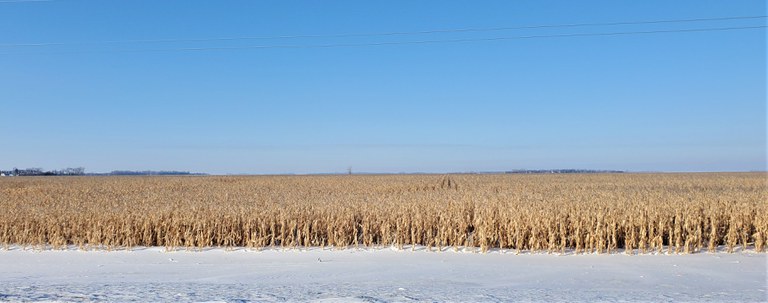Center Points
Standing Corn for Cow Feed
Unharvested corn fields spread across central North Dakota is a unique start to a new decade. Usually these fields have been combined, corn stalks baled and manure spread. Instead, the snow is deep and corn fields are soft with barely frozen soils, making mechanical harvest almost impossible.
Cows are well adapted to tough conditions and can harvest a corn field! A corn field can provide substantial amounts of feed for a cow herd. Depending on yield, grazing one acre of unharvested corn can feed 125-150 cows for a day. Unfortunately, cows can also develop digestive problems when given access to an unharvested corn field. Cows experienced in eating corn in an unharvested field will immediately start grabbing ears of corn and shelling the grain. Naive cows will figure out ear corn grain about 7 to 10 days after introduction to the corn field.
Eating too much corn grain at one time leads to acidosis. Acidosis is the result of rumen microbes fermenting corn and producing high concentrations of acidic chemicals like lactic acid – also known as lactic acidosis. Death loss due to acidosis is variable. Some herds will have no deaths while other herds incur 5-10%. Some cows develop an acidosis but don’t die. Instead these cows develop fonder where long toes and stiff shoulders develop over time and the cow is sold due to mobility problems. Bloat may also occur.
 Unharvested corn fields are common in central North Dakota this winter.
Unharvested corn fields are common in central North Dakota this winter.
Some cow herd owners have routinely planted corn for fall grazing and incur no problems. Maybe those herds have, overtime, selected for cows that have learned how to eat a standing corn field without developing digestive problems.
Another cow health concern of feeding/grazing light test weight, high moisture corn is mold. Some of these molds can lead to abortion or other health problems. While usually not a problem, the risk of severity can be at 30% abortion and 10% dead cows as reported in one cow herd several years ago. The NDSU Veterinary Diagnostic Laboratory does feed toxicology testing. You can find more information here: https://www.vdl.ndsu.edu/.
Hungry cows will aggressively graze a corn field. Providing plenty of free-choice hay for 2 to 3 days before grazing cows on a corn field may help decrease digestive problems.
Karl Hoppe, Ph.D.
Karl.Hoppe@ndsu.edu
Extension Livestock Systems Specialist


 NCR-SAREFarmPoster.pdf
NCR-SAREFarmPoster.pdf
